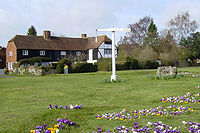
A Knight's Tale is a 2001 American medieval action comedy film written, co-produced and directed by Brian Helgeland. The film stars Heath Ledger as William Thatcher, a peasant squire who poses as a knight and competes in tournaments, winning accolades and acquiring friendships with such historical figures as Edward the Black Prince and Geoffrey Chaucer. Its 14th-century story is intentionally anachronistic, with many modern pop culture references and a soundtrack featuring 1970s music. The film takes its name from Chaucer's The Knight's Tale, part of The Canterbury Tales, and also draws several plot points from Chaucer's work.

Jousting is a medieval and renaissance martial game or hastilude between two combatants either on horse or on foot. The joust became an iconic characteristic of the knight in Romantic medievalism.
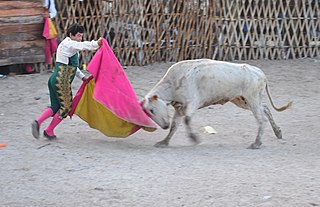
A bullfighter is a performer in the activity of bullfighting. Torero or toureiro, both from Latin taurarius, are the Spanish and Portuguese words for bullfighter, and describe all the performers in the activity of bullfighting as practised in Spain, Portugal, Mexico, Peru, France, Colombia, Ecuador, Venezuela and other countries influenced by Portuguese and Spanish culture. The main performer and leader of the entourage in a bullfight, and who finally kills the bull, is addressed as maestro (master), or with the formal title matador de toros. The other bullfighters in the entourage are called subalternos and their suits are embroidered in silver as opposed to the matador's gold. They include the picadores, rejoneadores, and banderilleros.

A tournament, or tourney, was a chivalrous competition or mock fight in the Middle Ages and Renaissance, and is a type of hastilude. Tournaments included mêlée, hand-to-hand combat, contests of strength, accuracy, and sometimes jousts. Although some thought that the tournaments were a threat to public order, the shows were still often held to celebrate coronations, marriages of notable figures, births, recent conquests, peace treatises; to welcome those considered of great importance, such as ambassadors and lords; or for no particular reason at all, and simply for entertainment. Certain tournaments are depicted throughout the Codex Manesse.

A pauldron is a component of plate armor that evolved from spaulders in the 15th century. As with spaulders, pauldrons cover the shoulder area. Pauldrons tend to be larger than spaulders, covering the armpit, and sometimes parts of the back and chest. A pauldron typically consists of a single large dome-shaped piece to cover the shoulder with multiple lames attached to it to defend the arm and upper shoulder. On some suits of armour, especially those of Italian design, the pauldrons would usually be asymmetrical, with one pauldron covering less and sporting a cut-away to make room for a lance rest.

Combat reenactment is a side of historical reenactment which aims to depict historical forms of combat. This may refer to either single combat, melees involving small groups, or nearly full-scale battles with hundreds of participants.

Hamsey is a civil parish in the Lewes District of East Sussex, England. The parish covers a large area and consists of the villages of Hamsey, Offham and Cooksbridge. The main centres of population in the parish are now Offham and Cooksbridge. Around the main settlements are enlarged fields, isolated old cottages and farms. The winding and undulating parish lanes between banks, old hedge rows, trees, flowery verges and ditches are popular with cyclists and give good views of the Downs.
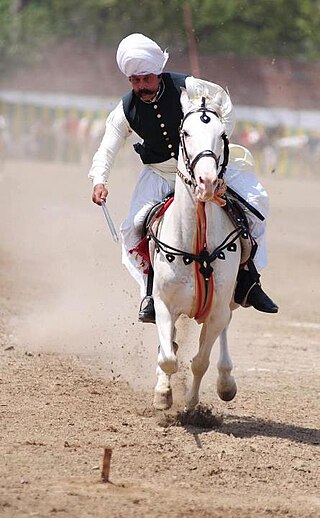
Tent pegging is a cavalry sport of ancient origin, and is one of only ten equestrian disciplines officially recognised by the International Equestrian Federation. Used narrowly, the term refers to a specific mounted game with ground targets. More broadly, it refers to the entire class of mounted cavalry games involving pointed and edged weapons on horseback, for which the term "equestrian skill-at-arms" is also used.

Animals in sport are a specific form of working animals. Many animals, at least in more commercial sports, are highly trained. Two of the most common animals in sport are horses and dogs.
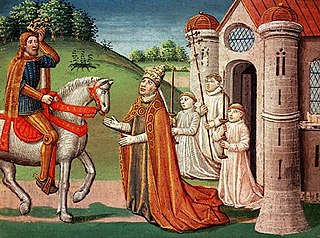
Horses in the Middle Ages differed in size, build and breed from the modern horse, and were, on average, smaller. They were also more central to society than their modern counterparts, being essential for war, agriculture, and transport.

Offham is a village in the local government district of Tonbridge and Malling in Kent, England, five miles to the west of Maidstone.
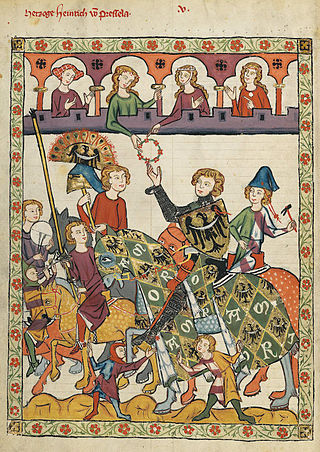
Hastilude is a generic term used in the Middle Ages to refer to many kinds of martial games. The word comes from the Latin hastiludium, literally "lance game". By the 14th century, the term usually excluded tournaments and was used to describe the other games collectively; this seems to have coincided with the increasing preference for ritualistic and individualistic games over the traditional mêlée style.

The Accession Day tilts were a series of elaborate festivities held annually at the court of Elizabeth I of England to celebrate her Accession Day, 17 November, also known as Queen's Day. The tilts combined theatrical elements with jousting, in which Elizabeth's courtiers competed to outdo each other in allegorical armour and costume, poetry, and pageantry to exalt the queen and her realm of England.

Full Metal Jousting is an American reality game show that debuted on the History Channel on February 12, 2012. The show featured 16 contestants, split into two teams of eight, competing in full-contact competitive jousting, a combat sport developed by host Shane Adams since the late 1990s. One by one, the contestants were eliminated tournament-style until only one remained. That contestant received a $100,000 grand prize.
An equestrian seal is a type of seal used in the European Middle Ages, characterized by the depiction of the owner as a mounted warrior in full armour. Originating in the high medieval period, the type was frequently used throughout the 13th to 14th centuries. Continued use into the 15th and 16th centuries was mostly limited to high nobility, especially royalty, while lower nobility switched to the use of simple heraldic seals.
Ježica is a formerly independent settlement in the northern part of the capital Ljubljana in central Slovenia. It is part of the traditional region of Upper Carniola and is now included with the rest of the municipality in the Central Slovenia Statistical Region.
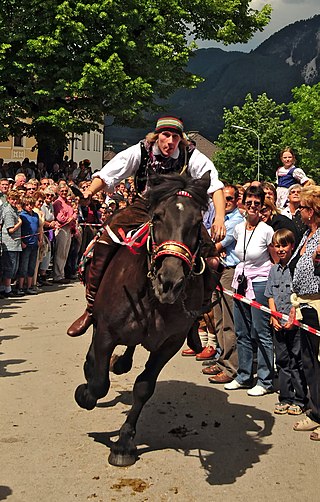
Slovene quintain is a traditional Slovene mounted folk game, a form of jousting, that has been preserved in the southern Austrian state of Carinthia. It is held during Kirchweih festivals in the lower Gail Valley, where it has become a major tourist attraction. The štehvanje competition has also taken place every year in Savlje, Ljubljana and sometimes in neighboring villages since the 1930s.
The Ripon Millenary Festival was a pageant and festival held in Ripon over a week in August 1886, with the main activities concentrated on two days, to celebrate the supposed millenary of the granting of a royal charter to Ripon by Alfred the Great.
Running at the ring, riding at the ring or tilting at the ring is an equestrian tournament activity originally practiced at European royal courts and likely derived from other lance games like quintain. It gained new popularity at Natural Chimneys near Mount Solon, Virginia, possibly as early as the 1820s, and since 1962, has been the state sport of Maryland. A similar contest, the corrida de sortija, is held in Argentina where it is considered a gaucho sport derived from the Spanish tradition of medieval tournaments.



